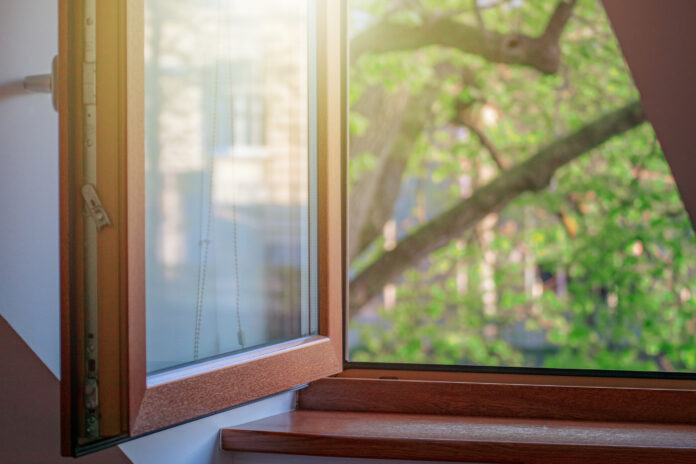Smelling noxious fumes on a busy highway or near an airport, you may wish you were safe at home breathing clean air. Actually, the air at home may be as much in need of a good cleanup as the air on the road or near a factory. A growing body of scientific evidence shows that the air quality at home, whether you live in the city, the country, or a suburb, is often more heavily polluted than the air outside. Most people spend more time indoors than out, and more time at home than anywhere else. Dr. Kirk Smith of the Wellness Letter Editorial Board cites what he calls “the rule of 1,000.” This means that pollutants released indoors are 1,000 times more important in causing human exposure than the same pollutants outdoors.
Tobacco smoke is by far the worst pollutant, but even if you have a smoke-free home, many things can impact air quality at home, notably the following:
- Cooking, especially on a gas range; fires in a fireplace or woodstove; an unvented or malfunctioning furnace; burning incense or candles; or any other form of combustion.
- Air fresheners and deodorizers.
- Insecticides, including mothballs.
Worry but don’t worry?
How much should you worry? Some indoor pollutants, such as carbon monoxide, are toxic and even fatal at high levels, and you should keep them under strict control. Others, such as the volatile substances that evaporate from dry cleaning or air fresheners, are potentially carcinogenic at high levels, but no one knows what effects they may have at the levels commonly measured in homes. Nobody is saying that having a fire in your fireplace or burning a scented candle will make you sick, let alone kill you. There’s no evidence that brief, low level exposure even to powerful chemicals like DDT will cause any harm. Some researchers suspect that some home pollutants might promote heart attacks or breast cancer, but there is no evidence that this is so. People with asthma or those with lung or cardiovascular diseases are most susceptible to indoor pollutants. Even low levels of pollutants may actually make them sick.
There is a lot to learn. The link—if there is one—between air pollution in the home and health is of growing interest to scientists. One example: A recent paper by Stanford researchers, published in the journal Environmental Science and Technology, that reports natural gas and propane stoves both “emitted detectable and repeatable levels of benzene that in some homes raised indoor benzene concentrations above well-established health benchmarks.” Other studies have measured the prevalence of indoor-generated particles, reporting on the impacts of cooking, dryers, candles and more.
We all have to cook, run the vacuum cleaner occasionally, use heating equipment, or make a fire in the fireplace. There’s no such thing as a combustion-free, dust-free, particle-free home. Carbon monoxide and tobacco smoke can and should be eliminated; other pollutants can be controlled. Sometimes it’s simple—for example, nobody really needs air fresheners or mothballs. Sometimes it’s expensive, as with repairing a leaking roof, reducing radon in the basement, or installing an-up-to-date furnace. Sometimes it’s a matter of following good practices—regularly cleaning furnaces and flues, for instance.
How to detect a problem
Many pollutants are not visible or detectable by smell. Still, if you notice unpleasant smells, or if you constantly feel the need to cover up odors, you have a problem.
Ironically, if you live in a well-insulated, energy-efficient home where windows and doors fit tightly, you are more likely to have polluted air than if you live in a drafty house with poor insulation and old windows and doors. On the plus side, a new house is more likely to have an efficient furnace, vented appliances, vented range hoods, and bathrooms with exhaust fans.
Physical signs of exposure include symptoms that hit more than one household member at once; headaches that seem to bother you when you’re at home but clear up when you leave; fatigue, irritated eyes, coughing, skin rashes, and dizziness. The adverse effects depend on individual sensitivities, as well as the levels and types of pollutants.
Ventilation is the key
Maintaining a flow of air in your living space is the basic way to combat indoor pollution. Open windows and doors as often as possible. Even in cold weather, keep a window partly open. The second step is to use venting systems in bathrooms, kitchens, and any room with a fireplace, woodstove, or range. If you have no venting hood on your kitchen range, at least open a window, turn on a window fan, or run the air conditioner with the vent open while cooking. Cut back on cooking methods that produce the most pollution, such as frying or sautéing.
These potentially harmful substances are found in the air of the average home in concentrations higher than outdoors:
Pollutant: Benzene
Possible Sources: Tobacco smoke, auto exhaust from street or attached garage, cooking gas.
Pollutant: Chloroform
Possible Sources: Chlorinated water used in bathing, showering, washing machines.
Pollutant: Formaldehyde
Possible Sources: Pressed-wood cabinets, unfinished particleboard, permanent-press draperies.
Pollutant: PAHs (polyaromatic hydrocarbons)
Possible Sources: Burning organic matter, candles browning or charbroiling meats.
Pollutant: Paradicholorobenzene
Possible Sources: Air fresheners and deodorizers, mothballs.
Pollutant: Perchloroethylene
Possible Sources: Residue on freshly dry-cleaned clothes.
Pollutant: Other volatile chemicals
Possible Sources: Spray cleaners, waxes, personal products, fresheners, nail polish, spray deodorants.
Pollutant: Particles
Possible Sources: Dust, cooking particles, tobacco smoke, fireplaces, animal dander, dust mites.
Pollutant: Mold, mildew
Possible Sources: Humidifiers, dampness, leaks.
Pollutant: Pesticides
Possible Sources: Household or garden pesticides tracked indoors, flea powder, pet shampoo.
Signs of poor ventilation: Moisture collecting on windows or walls, an air conditioner that smells bad, items on a shelf or in a closet that turn musty, or perpetually stale bathroom air.
Other steps to better indoor air
-
- Don’t smoke or allow smoking in your home.
- Be sure all appliances are properly vented. If you have a vent fan, use it.
- Don’t use air fresheners, scented candles, or incense. They mask rather than remove odors. Air fresheners actually pollute indoor air with such potential carcinogens as paradichlorobenzene and limonene; scented candles produce polyaromatic hydrocarbons (PAHs, like those produced by charbroiling).
- Avoid mothballs. They produce paradichlorobenzene and naphthalene fumes, which if inhaled in sufficient amounts can make you sick. People sometimes wear sweaters (or sleep under blankets) that smell of mothballs—not a great idea. To combat moths, clean clothes before storing: wash washables and dry-clean woolens. Store clothes in airtight containers without mothballs.
- Newly dry-cleaned clothes can temporarily raise pollution levels. If you notice a chemical smell, remove the plastic bags and air the clothing out—outdoors if possible—before wearing.
- Wash new permanent-press and cotton fabrics (especially linens and towels) before use. Many labels direct you to do so. This gets rid of sizing and other chemicals.
- Use a high-quality doormat, since shoes can track in pesticides, dirt, and other kinds of pollutants. If you have crawling babies or toddlers who pick things up from the floor, consider setting up a shoe removal area just outside the door for family and guests. The floors will stay cleaner.
- Vacuum floors and rugs frequently. If you have allergies—especially to dust, dander, dust mites, or pollen—get micro-filtration bags for your vacuum cleaner. These have a two-ply design that can trap many of the smallest particles. Such filters cost more than the standard ones and may fit only certain vacuum models. There are also electrostatic filters that fit over the exhaust of some models. Consider buying a vacuum cleaner with a HEPA (high-efficiency particulate-arresting) filter.
- If you are buying and/or installing new carpet, ask the retailer for carpet, padding, and adhesives that have the lowest emissions. Ask whether the installer will follow the Carpet and Rug Institute’s guidelines, which were designed to reduce emissions. Increase ventilation for two or three days after installation.
- Be sure your bathroom is properly vented, and use the fan when you’re showering or bathing. Open a window; run the vent fan to disperse bathroom smells; don’t use deodorizers.
- Use hair sprays, nail polish, polish removers, and spray perfumes sparingly and in well-ventilated areas.
- If you are buying unfinished pressed-wood furniture or building materials, buy those stamped with the HUD (Housing and Urban Development) emissions seal. Government regulations have reduced the formaldehyde content of many products.
- Use pesticides sparingly. Investigate nonchemical methods. Consider using a pest control company for persistent problems. Ask in advance how it plans to minimize exposure for humans and pets. Most states require certification and licensing.
- To combat mold, keep indoor humidity below 50%. Use air conditioners in warm, humid weather. If you use a humidifier in winter, clean and disinfect it often.
- Don’t rely on air-cleaning machines. Though the best portable and in-duct machines can reduce some fine particles when used correctly, independent studies have shown that they do not remove gaseous pollutants or ultra-fine particles from indoor air, destroy microbes, remove odors, or control most allergens.
- No studies have clearly shown that these machines provide health benefits. In no case should portable devices be used in small, poorly ventilated rooms. They may produce ozone, a dangerous pollutant. According to the EPA, air-filtering machines are helpful only when combined with good ventilation and source control. Consumer Reports provides ratings of many machines. The California Air Resources Board supplies a list of machines that produce hazardous amounts of ozone (www.arb.ca.gov/research/indoor/ozone.htm).
You should test your home for radon, particularly if you live in a part of the country where radon is prevalent. (For a map and other information call 800-SOS-RADON or visit www.epa.gov/radon. You can ask for the 15-page “Citizen’s Guide to Radon” or consult the booklet online.) Radon is an invisible, odorless radioactive gas found naturally in soil and water. It can seep into a house through cracks in the foundation as well as construction joints. Radon is the second leading cause of lung cancer, and about one in every 15 homes in the U.S. has elevated levels (depending on local geology and building construction). Radon is especially risky for smokers. It is almost impossible to predict which houses have radon, but you can find out whether your home does with a simple, inexpensive, do-it-yourself test kit, available at hardware stores. Radon problems can be fixed by installing special ventilation systems and sealing foundation cracks.
CO: a detective story
A colorless, odorless gas, carbon monoxide (CO) sickens thousands of Americans a year and kills more than 400. If you have gas or oil-burning appliances (furnaces, ovens, water heaters), take these steps to protect yourself against CO:
-
-
- Install CO detectors outside all bedrooms—it’s the law in some cities and states. They usually cost $25 or less and are easy to mount. Look for an Underwriter’s Laboratory (UL) seal. Some come with a smoke alarm.
- Make certain your furnace, water heater, gas range, and gas clothes dryer are in good working order and properly vented to the outdoors. Have them cleaned and adjusted on a regular schedule. Clean flues on a regular basis. Install and use an exhaust fan over a gas range.
- Don’t cook with charcoal indoors (including houseboats and motor homes or trailers).
- Never run your car engine in a garage, particularly an attached garage. Thanks to new regulations, CO emissions from automobiles are much lower than they used to be.
-





